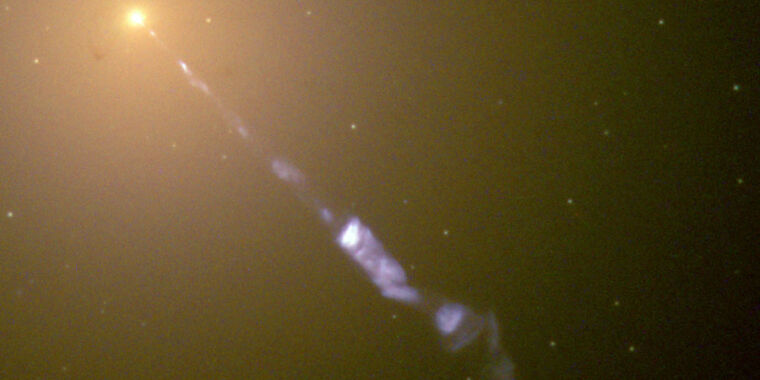
There are recycling signs everywhere on Earth urging us to save our planet while we still can. In space, some galaxies apparently recycle without any sign to remind them.
At least one galaxy isn’t wasting materials that could form potential stars. An international team of scientists led by astronomers Shiwu Zhang and Zheng Cai of Tsinghua University in China has found evidence that a huge galaxy in an even larger nebula, called MAMMOTH-1, is pulling material from its environment to form new stars.
However, that material contains elements formed by past supernovae believed to have happened in galaxies, with the elements they created being flung into the nebula by the galaxy’s central black hole. This means that the galaxy, which the research team refers to as G-2, is now forming stars from material previously flung into intergalactic space by a galaxy – either itself or another nearby one.
“Simulations have shown that gas recycling — the reacquisition of gas previously ejected from a galaxy — could sustain star formation in the early Universe,” the researchers said in a study recently published in Science.
Recycling, stellar style
Stars feed themselves with the energy that comes from nuclear fusion, where hydrogen atoms fuse together to form helium. Only massive stars (8 solar masses or more) go supernova after fusing all their hydrogen into helium. Gravity then causes the collapse of a massive star, which soon erupts in an extremely bright explosion that blows away its outer layers. Supernovae create shock waves that can generate enough force to fuse new atomic nuclei, even metals such as iron.
But the afterlife of one star can mean the birth of another. After the explosion, the remains of the dead star scatter into space, swirling in the interstellar medium. While some of this material is lost to space forever, stars may still contain some of the material created in the supernova.
The heavier elements created by supernovae could act as tracers for when stars have absorbed the remnants of a previous generation of stars. While the majority of a newly formed star will always be hydrogen and helium, the extent to which there are heavier elements tells us something about the history of the material used in its creation.
Don’t cross the streams
Star formation resources are abundant in the MAMMOTH-1 nebula, and observations from the Subaru and Keck II telescopes have revealed three gaseous streams flowing from the nebula to one of the galaxies within it. MAMMOTH-1 is a very large nebula that lives up to its name. The gas streams from this nebula extend an astonishing distance of 100 kiloparsecs (325,000 light-years) from the host galaxy. These streams could provide the galaxy with what is news for a new generation of stars.
The research team created kinematic models, which show the movement of an object, of both the galaxy and the nebula, to see exactly how the gas streams moved. It appears that the streams are spiraling inward toward the galaxy, which they say is more evidence of an immense material that can be recycled into new stars.
The Subaru and Keck II observations revealed that these streams glowed with emission lines indicating the presence of hydrogen and helium, which was to be expected. But there were also significant amounts of carbon. The presence of carbon shows that the cloud contains heavier elements that probably come from stars that have long since died.
Another thing discovered in the MAMMOTH-1 observations was that two of the streams of gas that went into the galaxy and pulled them in came from the same quasar. Quasars form when supermassive black holes at the center of galaxies devour enough material to emit jets of material and extreme radiation. These jets can completely eject material from the galaxy
The researchers determined that this quasar is most likely not in the same galaxy that attracts the material. So this seems to be a case where one galaxy recycles the material shed from another.
Science, 2023. DOI: 10.1126/science.abj9192
Elizabeth Rayne is a creature that writes. Her work has appeared on SYFY WIRE, Space.com, Live Science, Grunge, Den of Geek, and Forbidden Futures. When she’s not writing, she’s transforming, drawing, or cosplaying as a character she’s never heard of before. Follow her on Twitter @quothravenrayne

